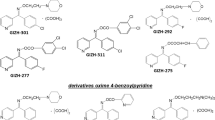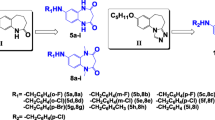Abstract
The anticonvulsant activity of bis(acetato)tetrakis(imidazole) copper(II), Cu(OAc)2(Im)4, was studied in normal mice using chemical convulsions induced by strychnine, thiosemicarbazide, picrotoxin, and pentelenetetrazol. Intraperitoneal administration of Cu(OAc) 2(Im)4, 50 mg/kg body mass, has delayed the onset of strychnine (3 mg/kg)-induced convulsion by 204% (p≤0.005) and thiosemicarbazide (20 mg/kg)-induced convulsant by 61% (p≤0.005). The changes in the onset of picrotoxin-(6 mg/kg) and pentelenetetrazol (50 mg/kg)-induced convulsions were not significant. The same dosage of the copper compound was effective in delaying the lethal time and reducing the mortality rate of treated animals. The anticonvulsant activity of Cu(OAc) 2(Im)4 complex against strychnine was not related to its constituents because the inorganic form of copper such as copper chloride, copper acetate, and the parent imidazole has no anticonvulsant activity. Other copper(II) complexes like copper(II)aspirinate and bis(acetato)bis(2-methyl imidazole) copper(II) were less effective.
Similar content being viewed by others
References
J. R. Prohaska, Biochemical functions of copper in animals, in Essential and Toxic Trace Elements in Human Health and Disease, A. S. Prasad, ed., Liss, New York, pp. 105–124 (1988).
J. R. J. Sorenson, Copper complexes offer a physiological approach to treatment of chronic diseases, Prog. Med. Chem. 26, 437–568 (1989).
E. I. Solomon, U. M. Sundaram, and T. E. Machonkin, Multicopper oxidases and oxygenases, Chem. Rev. 96, 2563–2605 (1996).
L. W. Oberley, S. W. Leuthauser, R. F. Pasternack, T. D. Obeley, L. Schutt, and J. R. J. Sorenson, Anticancer activity of metal compounds with superoxide dismutaze activity, Agents Actions 15, 535–538 (1984).
J. R. J. Sorenson, Copper chelates as possible active forms of antiarthritic agents, J. Med. Chem. 19, 135–148 (1976).
D. H. Brown, W. E. Smith, and J. W. Teape, Anti-inflammatory effects of some copper complexes, J. Med. Chem. 23, 729–734 (1980).
J. R. J. Sorenson, L. W. Oberley, and V. Kishore, Copper complexes: a physiological approach to the treatment of inflammatory diseases, Inorg. Chim. Acta 91, 285–294 (1984).
S. Okuyama, S. Hashimoto, H. Aihara, W. M. Willingham, and J. R. J. Sorenson. Copper complexes of non-steroidal anti-inflammatory agents: analgesic activity and possible opioid receptor activation, Agents Actions 21, 130–144 (1989).
J. R. J. Sorenson, K. Ramakrishna, and T. M. Rolniak, Antiulcer activities of d-penicillamine copper complexes, Agents Actions 12(3), 408–411 (1982).
J. R. J. Sorenson, L. W. Oberley, R. K. Crouch, et al., Pharmacologic activities of copper compounds in chronic diseases, Biol. Trace Element Res. 5, 257–274 (1983).
A. Agrawal, N. Singh, R. Agrawal, A. Sedhi, and P. Tandon, Synthesis, structure, and antitumor activity of N-salicylcyl-N-(2-furyl thiocarbonyl) hydrazine and its copper(II) complex, J. Med. Chem. 29, 199 (1986).
S. E. Gandy, M. G. Buse, J. R. J. Sorenson, and R. K. Crouch, Attenuation of streptozotocin diabetes with superoxide dismutase like copper(II) (3,5-diisopropyl-salicylate)2 in the rat, Diabetologia 24(6), 437–440 (1993).
A-S. Abdul-Ghani, A. L. AbuHijleh, N. Nahas, and R. Amin, Hypoglycemic effect of copper(II) acetate imidazole complexes. Biol. Trace Element Res. 54, 143–151 (1996).
J. R. J. Sorenson Cu, Fe, Mn, and Zn chelates offer a medicinal chemistry approach to overcoming radiation injury, Curr. Med. Chem. 9, 639–662 (2002).
J. R. J. Sorenson, L. S. F. Soderberg, L. W. Chang, et al., Copper-, iron-, manganese- and zinc-3,5-diisopropylsalicylate complexes increase survival of gamma-irradiated mice, Eur. J. Med. Chem. 28, 221–229 (1993).
D. Suriyachan, S. Patarakitvanit, and P. Ratananakorn, R. Thai Army Med. J. 42, 145–148 (1989).
J. R. J. Sorenson, Copper chelates as possible active metabolites of the antiarthritic and antiepileptic drugs, J. Appl. Nutr. 32, 4–9 (1980).
G. Alznet, S. Ferrer, J. Borras, and J. R. J. Sorenson. Anticonvulsant properties of copper acetazoleamide complexes, J. Inorg. Biochem. 55(2), 147–151 (1994).
P. Y. Boukan, E. A. Busnot, F. Busnot, A. Laclaire, and T. A. Bernard, Structure du di-μ-acetato-bis[acetato bis(methyl-1 imidazol) cuivre(II)]hexahydrate, Acta Crystall. B38, 2458–2461 (1982).
P. Lemoine, B. Viossat, G. Morgant, et al., Synthesis, crystal structure, EPR properties and anticonvulsant activities of binuclear and mononuclear 1,10-phenanthroline and salicylate ternary copper (II) complexes J. Inorg. Biochem. 89, 18–28 (2002).
K. Wada, Y. Fujibayashi, and A. Yokoyama, Copper(II) 2,3-butanedionebis(N4-methylthiosemicarbazone) stable superoxide dismutase-like copper complex with high membrane penetrability, Arch Biochem. Biophys. 310, 1–5 (1994).
N. Horn, K. Heydorn, E. Damsgaard, I. Tygstrup and S. Vestermark, Is Menkes syndrome a copper storage disorder? Clin. Gen. 14, 186–187 (1978).
S. Greenfield, W. T. Norton, and P. Morell, Quaking mouse: isolation and characterization of mylein protein, J. Neurochem. 18, 2119–2128 (1971).
D. M. Hunt, Primary defect in copper transport underlies mottled mutants in the mouse, Nature 249, 852–854 (1974).
T. R. Price and P. M. Silberfarb, Convulsions following disulfiram treatment, Am. J. Psychol. 133, 235 (1976) (letter).
A. L. AbuHijleh, C. Wood, and I. Y. Ahmed, Synthesis and molecular structure of monomeric copper(II) acetate with 2-methylimidazole and 1,2-dimethylimidazole, Inorg. Chim. Acta 190, 11–17 (1991).
A. L. Abu-Hijleh and C. Woods, Synthesis, spectroscopic and structural characterization of bis(acetato) tetrakis(imidazole) copper(II): a model complex of DNA binding, Inorg. Chim. Acta 194, 9–14 (1992).
R. L. Krall, J. K. Penry, B. G. White, H. J. Kupferburg, and E. A. Swinyard, Antiepileptic drug development. II Anticonvulsant drug screening, Epilepsia 19, 409–428 (1978).
B. S. Meldrum, Epilepsy, in Molecular Basis of Neuropathology, A. N. Davison and R. H. Thompson, eds., Edward Arnold, London, pp. 265–301 (1981).
W. Loscher, and H. H. Frey, Effect of convulsant and anticonvulsant agents on level and metabolism of GABA in mouse brain, Naunyn-Schmiedebergs Arch. Pharmacol. 296, 263–269 (1977).
Y. Yashino and K. A. C. Elliot, Effect of various conditions on the movement of carbon atoms derived from glucose into and out of proteins in rat brain, Can. J. Biochem. 48, 236–243 (1970).
B. L. Booth, E. Pitters, B. Mayer, and J. R. J. Sorenson, Down regulation of porcine heart diaphorase reactivity by trimanganese hexakis (3,5-diisopropyl salicylate) Mn 3(3,5-DIPS)6, and down regulation of nitric oxide synthase reactivity by Mn 3(3,5-DIPS)6 and Cu(II)2(3,5-DIPS)4, Metal-Based Drugs 6, 111–120 (1999).
G. Morgant, N.-H. Dung, J.-C. Daran, et al., Low-temperature crystal structures of tetrakis-μ-3,5-diisopropylsalicylatobis-dimethyl formamido dicopper (II) and tetrakis-μ-3,5-diisopropylsalicylatobis-diethyletheratodicopper(II) and their role in modulating polymorphonuclear leukocyte activity in overcoming seizures, J. Inorg. Biochem. 81, 11–22 (2000).
B. Viossat, J.-C. Duran, G. Savouret, et al., Low temperature (180 K) crystal structure, electron paramagnetic resonance spectroscopy, and propitious anticonvulsant activities of Cu(II)2(aspirinate)4(DMF)2 and other Cu(II)2(aspirinate)4 chelates, J. Inorg. Biochem. 96, 375–385 (2003).
M. S. Horning and P. Q. Trombley, Zinc and copper influence excitability of rat olfactory bulb neurons by multiple mechanisms, J. Neurophysiol. 86, 1652–1660 (2001).
J. R. J. Sorenson, D. O. Rauls, K. Ramakrishna, R. E. Stull, and A. N. Voldeng, in Trace Substances in Environmental Health-III. Anticonvulsant Activity of Some Copper Complexes, D. D. Hemphill, ed. University of Missouri Press, Columbia, MO, pp. 360–367 (1979).
H. H. A. Dollwet, J. B. McNicholas, A. Pezesk, and J. R. J. Sorenson, Superoxide dismutase-mimetic activity of antiepileptic drug copper complexes, Trace Elements Med. 4, 13–20 (1987).
Author information
Authors and Affiliations
Rights and permissions
About this article
Cite this article
Abdul-Ghani, AS., Abu-Hijleh, A.L. & Qazzaz, M. Effect of bis(acetato)tetrakis(imidazole) copper(II) in delaying the onset and reducing the mortality rate of strychnine- and thiosemicarbazide—Induced convulsions. Biol Trace Elem Res 101, 87–95 (2004). https://doi.org/10.1385/BTER:101:1:87
Received:
Revised:
Accepted:
Issue Date:
DOI: https://doi.org/10.1385/BTER:101:1:87




